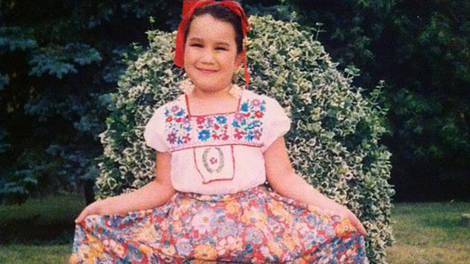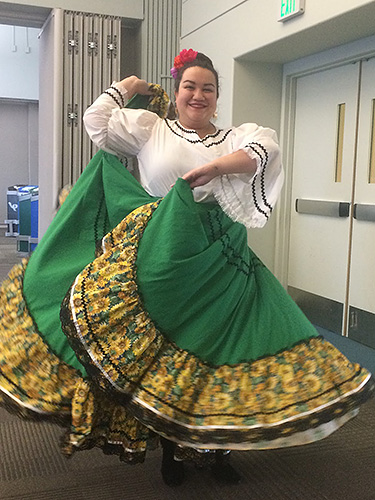
A collaborative publication of the Latin American Studies Program
Divisadero
Spring 2015
Vuela Paloma

We never appreciate the lessons we are taught while growing up. I didn’t realize it back then, but my parents helped keep our Mexican culture alive through dance by taking us to Xochiquetzal, a Mexican folkloric ballet class every Saturday morning. As a child I didn’t think anything of it. I just looked at it as going to hang out with a bunch of my cousins on Saturday mornings. Almost every partner I got paired with was related to me. Carpooling to performances was always with a tía. We would perform for local community events and special occasions throughout our city. When we were introduced, the speaker would always give a historical summary of the region where the dance was from.
The art of dance has been used to maintain cultures alive for centuries. In each region of Mexico there are different styles of dances. The Northern area of Mexico has a more cowboy look to it with denim fabrics. The central area of Mexico has large colorful skirts with ribbons along the edges. The indigenous regions, specifically the Yucatán have beautiful stich work with colorful flowers and lace. Along the coastal region of Veracruz they have beautiful white dresses full of lace and with a black apron that has colorful flowers stitched on the side.
The art of dance in Mexico has the blending of Indigenous, African, and Spanish roots. Before the arrival of the Spanish many dances were held for religious practices or to entertain the elite. Baile folklorico today is for entertainment and to keep Mexican traditions alive. Baile folklorico in the United States became popular in the 1960s and 70s in Los Angeles and El Paso. These two cities have a large Mexican community and wanted a way to promote the pride of their heritage. There are now baile folklorico dance crews all over the United States keeping that culture alive.
 When I got to USF it was hard to feel at home or to get that feeling of belonging. I’m a non-traditional, transfer student, meaning that I’m older than most university students, and to top it off I live off campus. Making friends is almost impossible if you don’t try to get involved with student organizations. My second semester, I decided to make time to get involved in an organization that was also going to be fun. Unfortunately, the only club I wanted to join, “Latinas Unidas” held meetings during my class time on Thursday evenings at 7. I gave up and decided to try again the following semester. A few weeks later, I was at a campus event luncheon that held a Mexican dance group performance made up of all female students. My childhood memories immediately came back and the steps became familiar.
When I got to USF it was hard to feel at home or to get that feeling of belonging. I’m a non-traditional, transfer student, meaning that I’m older than most university students, and to top it off I live off campus. Making friends is almost impossible if you don’t try to get involved with student organizations. My second semester, I decided to make time to get involved in an organization that was also going to be fun. Unfortunately, the only club I wanted to join, “Latinas Unidas” held meetings during my class time on Thursday evenings at 7. I gave up and decided to try again the following semester. A few weeks later, I was at a campus event luncheon that held a Mexican dance group performance made up of all female students. My childhood memories immediately came back and the steps became familiar.
My time in Xochiquetzal wasn’t long lived. By the age of 8 or 9 my parents couldn’t afford to send three kids to dance classes and we had to stop attending. I would sit in the audience and watch the older age division group perform with their gorgeous Jalisco dresses making giant circles with their colorful skirts and knowing that I wouldn’t be able to be a part of them.
I asked around campus and found out the meeting time and place for Baile Folklorico de San Pancho and dropped in on one of their practices. All of the girls were tremendously friendly and helpful with learning the dances. Our first performance took place at culturescape. It was amazing and I’ve stuck around to perform this semester as well at Dia de la Mujer. One of the dances I have come to love is Vuela Paloma. The giant hand movements of this dance makes grand circles with the skirts and makes me feel free like a dove. It finally gave me the chance to dance with colorful skirts that make designs in the air like a bird does with their wings.
Baile Folklorico de San Pancho gave me the sense of community and culture that I was brought up around. They also gave me the opportunity to dance and to fulfill my yearning for a chance to dance with not only the giant colorful skirts with ribbon edges I saw as a child but also the gorgeous white laced dresses from Veracruz. . The lessons I learned as a child I could now appreciate and carry the legacy my parents have passed on. I am extremely grateful that my parents used the art of dance as a way to create a national identity in our family. And I am extremely grateful that I have found that same family here at USF.
If you are interested in joining Baile Folklorico de San Pancho contact me at mmunoz2@usfca.edu
Images above: © Margarita Muñoz
